This website uses cookies This website uses cookies to improve user experience. By using our website you consent to all cookies in accordance with our Cookie Policy. Read more
Glossary
A comprehensive resource for understanding key terms and industry jargon in the security sector. This section offers clear definitions and explanations to enhance your familiarity with terminology, ensuring confident product selection.
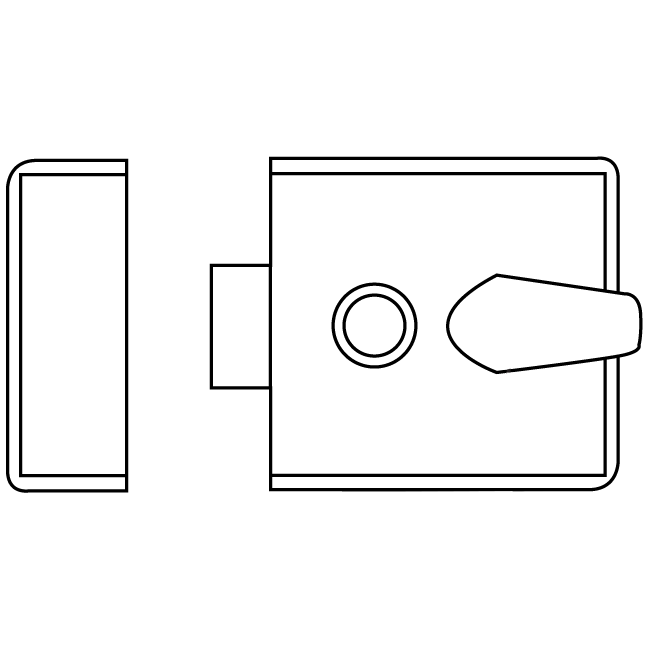

Automatic Deadlatch
An automatic deadlatch is a locking mechanism that secures a door automatically when it closes, engaging the main bolt without requiring a key. This feature enhances security by ensuring that the door is always locked when shut, preventing unauthorised access. Commonly used in commercial and residential applications, it offers convenience as users don’t need to manually lock the door. The automatic deadlatch is especially useful for high-traffic doors, where manual locking is impractical. Typically, it includes a release mechanism that allows the door to open from the inside, facilitating safe and easy exit in case of emergencies.
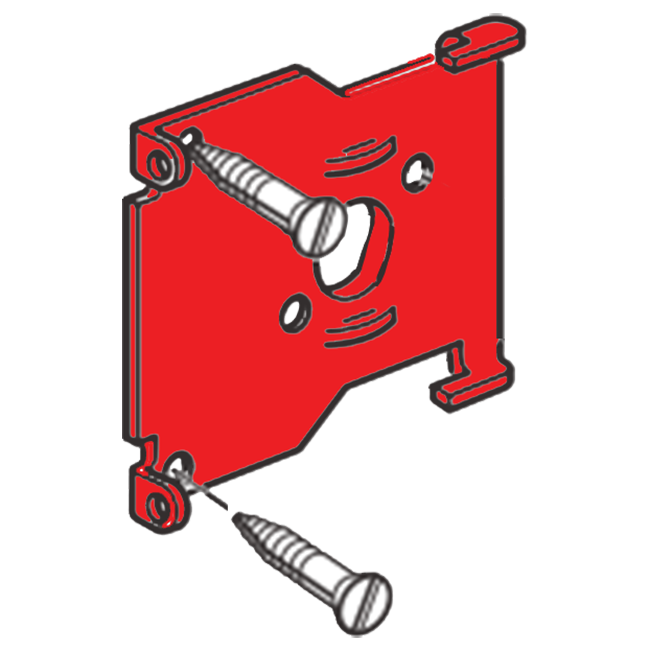

Backplate
The backplate is a sturdy metal or plastic plate mounted on a door where the lock is installed, providing a stable surface for attaching the locking mechanism. It often serves both functional and decorative purposes, aligning with door hardware aesthetics. By reinforcing the area around the lock, the backplate helps distribute force more evenly, reducing stress on the door material and minimising wear. In addition to enhancing durability, backplates often come in various finishes and styles, allowing homeowners or businesses to choose designs that complement their decor while ensuring that the lock remains securely affixed to the door.
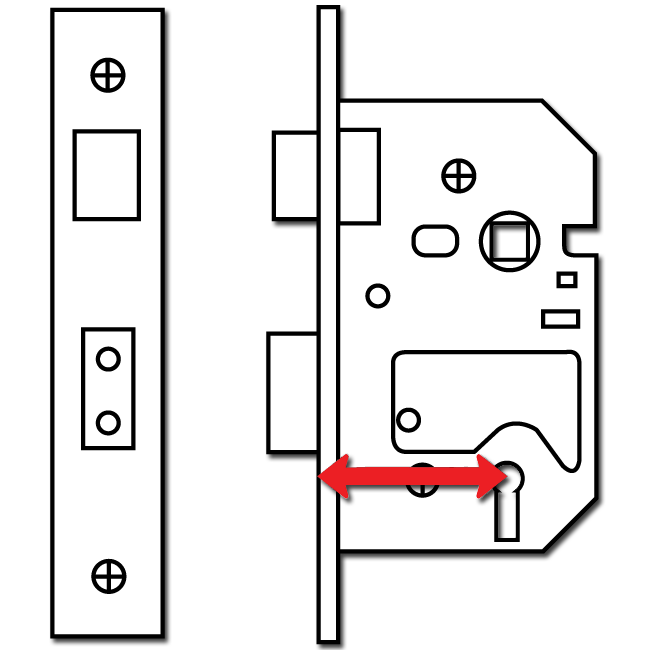

Backset
The backset is a critical measurement in door hardware installation, referring to the horizontal distance between the front edge of the door (forend face) and the center of the keyhole or follower. Accurate backset measurement is essential for proper lock placement, as it affects both security and usability. Common backset distances are 2 3/8 inches or 2 3/4 inches in residential applications, though this can vary in commercial settings. Choosing the correct backset ensures that the lock aligns correctly with the door handle or knob, providing both comfort and ease of access when using the door.
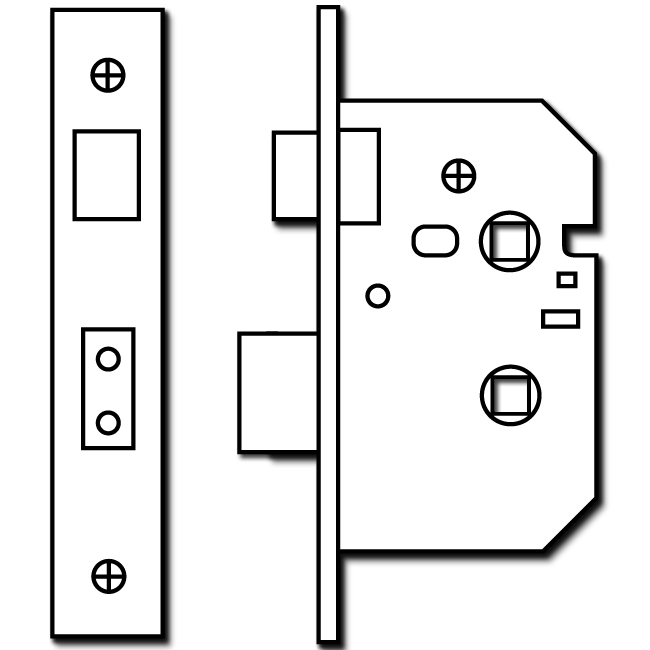

Bathroom Lock
A bathroom lock is designed specifically for bathroom privacy, allowing the door to be secured from the inside while preventing external access. It typically includes a latch bolt operated by the handle and a deadbolt that is locked and unlocked with a thumb turn on the interior side. Unlike exterior locks, bathroom locks prioritise privacy over security, allowing easy exit without a key. Some bathroom locks also feature an emergency release slot on the exterior, enabling access if necessary. This type of lock provides a practical solution for privacy in bathrooms, bedrooms, and other interior spaces where discretion is needed.
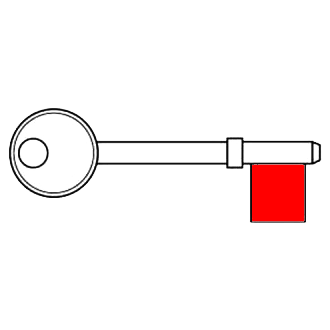

Bit (Key Bit)
The bit on a mortice key is the part that is precisely cut to match the corresponding lock’s mechanism, allowing it to engage or disengage the lock. The shape and cut of the bit determine how the key interacts with the levers or pins within the lock. When inserted, the bit lifts the lock's internal components to specific positions, permitting the lock to turn and unlock. The design of the bit makes it unique to each lock, adding a layer of security by ensuring that only a correctly cut key will operate the lock. The bit is essential for the functionality and security of traditional mortice locks.
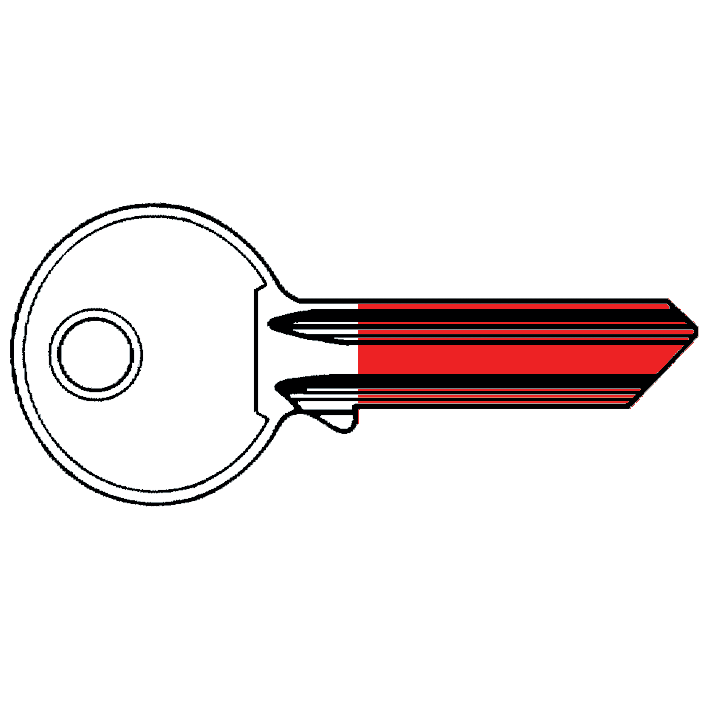

Blade
The blade is the part of a cylinder key blank that is cut to create a specific key pattern matching the lock it is intended to operate. Unlike the bow, which is the handle, the blade is inserted into the lock and interacts with the lock’s pins or levers. When the blade is cut, it takes on a pattern unique to the lock, allowing it to engage or disengage the mechanism. Key blades are carefully crafted to align with specific pin configurations in the lock, providing secure access while preventing unauthorised entry. The blade’s design is integral to a key’s functionality.
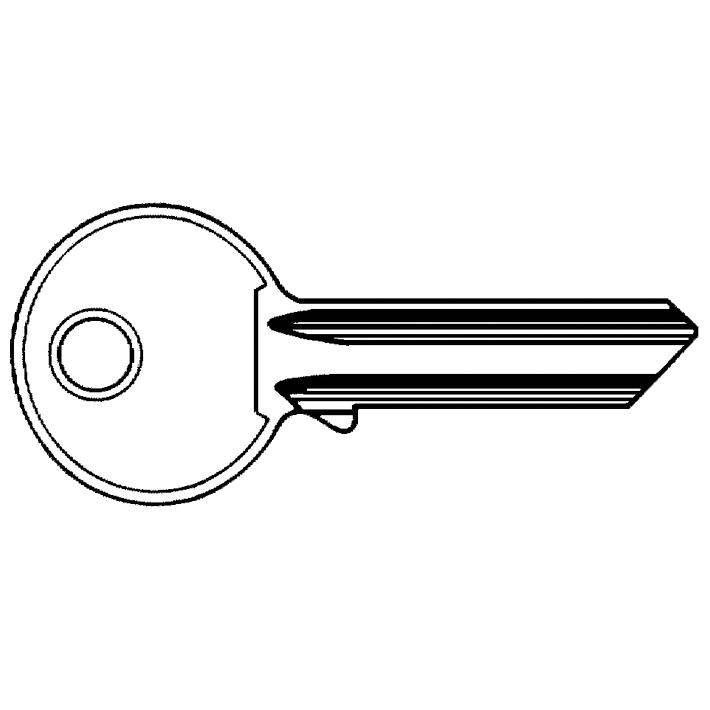

Blank
A blank is an uncut key, featuring a handle (bow) and a smooth blade, ready to be cut to match a specific lock’s configuration. Key blanks are used by locksmiths or key-cutting services to create custom keys based on the original. Each blank is typically made to fit a particular type of lock, such as a mortice or cylinder lock, and can be shaped to align with the internal components. Blanks allow for the replication of keys, providing convenience for those who need duplicates. A blank’s design and material are chosen to suit the lock's security needs and durability requirements.
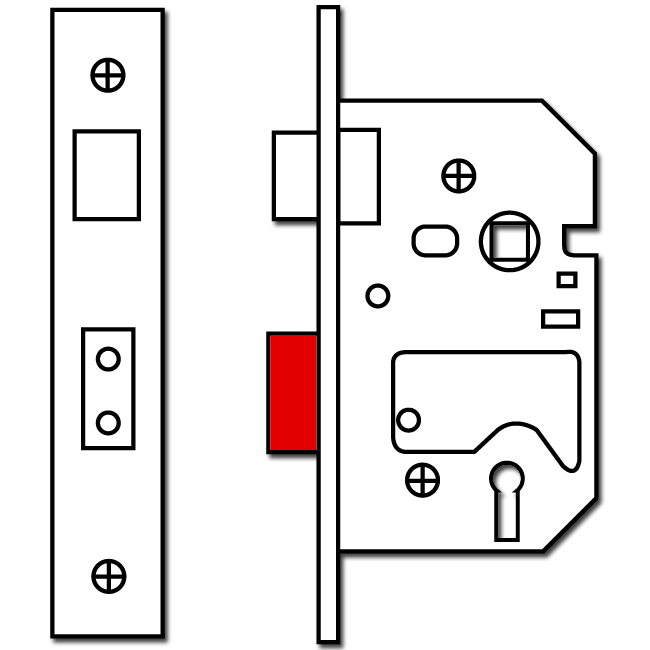

Bolt
The bolt is a crucial part of a locking mechanism, extending into the door frame to secure the door when locked. There are various types of bolts, including deadbolts and latch bolts. Deadbolts, for instance, are solid and typically require a key or thumb turn to engage, providing enhanced security as they resist forced entry. When the lock is engaged, the bolt moves into a hole or strike plate on the frame, anchoring the door in place. The strength and design of the bolt are central to a lock's effectiveness, making it an essential feature for both door security and durability.
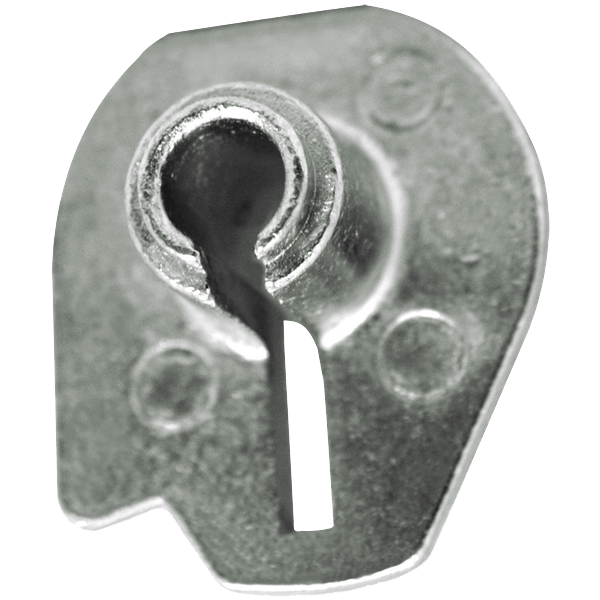

Bolt Thrower
When a user turns the key the bolt thrower (also known as a curtain) mechanism moves the bolt into the strike plate or door frame, effectively locking the door. The bolt thrower works by converting rotational motion (from turning a key or handle) into linear motion, driving the bolt forward or backward. The distance that the bolt extends into the frame, known as the “throw,” is an important measure of security; a longer throw means deeper engagement with the frame, making forced entry more difficult. Bolt throwers are precision-engineered for smooth, reliable operation, minimising the wear and tear on both the lock and the door.
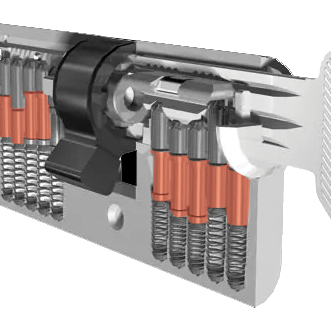

Bottom Pins
In a pin tumbler lock, the driver, or top pin, is the pin positioned directly above the key pin (or code pin). When the correct key is inserted, it aligns the driver with the key pin, creating the shear line that allows the lock to turn. The driver is essential to the lock's function, as it works in conjunction with the key pin to ensure that only the correct key can open the lock. This design is foundational in pin tumbler locks, widely used in residential and commercial security due to its effectiveness and reliability.
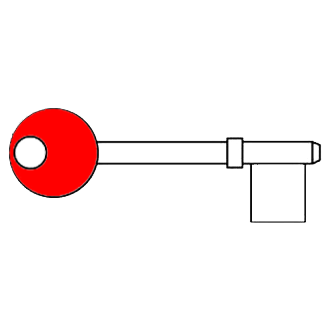

Bow
The bow is the handle or head of a key blank, providing users with a comfortable grip while turning the key in the lock. Usually designed with distinctive shapes or markings, the bow helps users identify individual keys. It is often made from durable materials like brass, steel, or aluminium to withstand frequent handling and wear. The bow’s design can also carry the manufacturer’s branding or be customised for aesthetic purposes. While not directly involved in the locking mechanism, the bow’s ergonomic design is crucial for ease of use, especially in high-traffic settings or for those with limited dexterity.
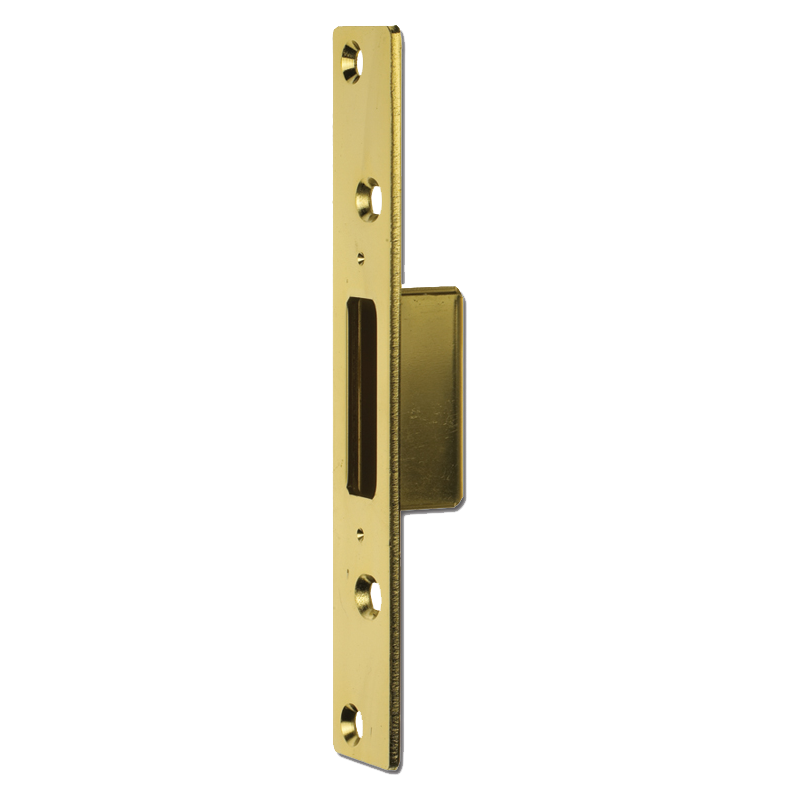

Box Strike Plate
A box strike plate is a reinforced metal plate with a box shape around the bolt hole, installed on the door frame where the bolt enters. This design provides extra support around the strike area, helping to distribute force more evenly and resist impact. Box strike plates enhance security by reinforcing the door frame, making forced entry more difficult. The box shape also provides a cleaner, more professional look around the bolt hole, protecting it from wear and tear. It’s commonly used with deadbolts and other high-security locks where additional door frame reinforcement is desirable.
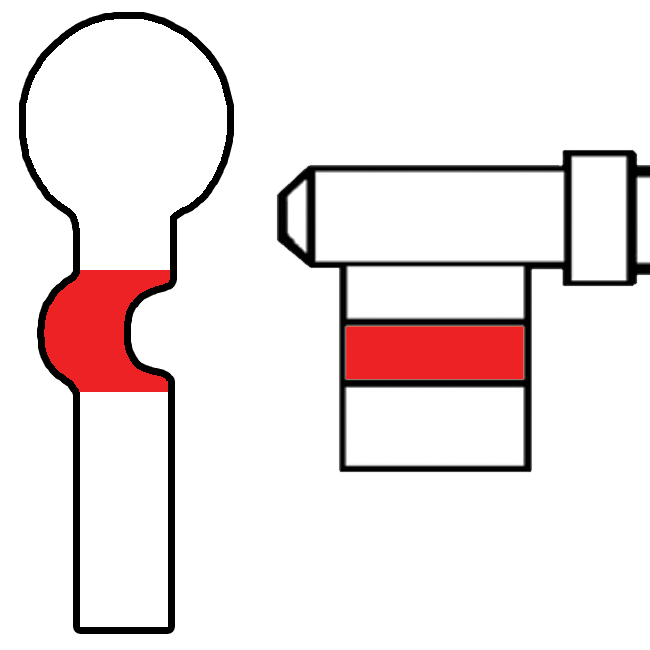

Bullet Ward
A bullet ward is named as the bit of the key looks like it has had a bullet shot down the side of it leaving a horizontal groove down the side of the key bit. The keyway is shaped the same so keys without this ward do not fit thus preventing incorrect keys from fully entering and reaching the lock’s internal mechanism. Wards provide a level of security by ensuring that only keys with the right profile can access the lock. Warded locks are an older design but remain popular in some applications. While wards are effective against unauthorised key use keys can be modified to fit and are therefore much less secure than modern locking mechanisms like pin tumblers.
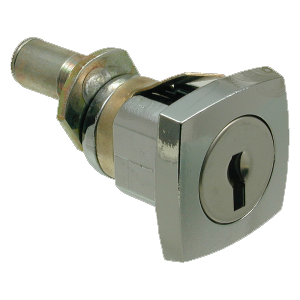

Cabinet Lock
A cabinet lock is a general term for locks used to secure drawers, cupboards, or storage boxes. These locks come in various styles, such as cam locks, latch locks, or deadbolt mechanisms, providing different levels of security. Cabinet locks are commonly used in residential, commercial, and office settings to protect valuable or sensitive items within furniture. They can be keyed alike or differently, depending on the user's needs. The compact design of cabinet locks makes them ideal for small, enclosed spaces, offering a balance of convenience and security for everyday items.
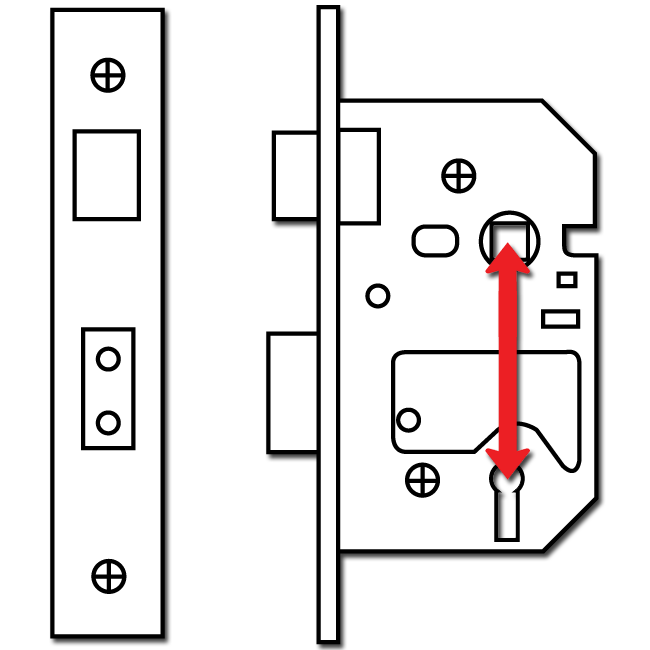

Centers
Centers refer to the vertical measurement between the center of the keyhole and the center of the follower hole on a sash lock. This measurement is crucial during lock installation, as it ensures the alignment of door hardware, such as handles or knobs, with the lock mechanism for smooth operation. Standard center measurements help installers match compatible hardware with the lock body. Inconsistent center measurements can lead to misalignment, making it difficult to operate the lock or compromising the door’s functionality. Centers play a significant role in the lock's usability, especially for sash and mortice locks.


Classroom Function
A classroom function lock includes a specialised ratchet mechanism that restricts thumb turn rotation to one direction. This configuration allows the door to be unlocked from the inside at any time but prevents someone from locking out others from the outside. This lock style ensures safety and controlled access, commonly used in educational settings to allow free egress during emergencies. The classroom function lock’s design makes it ideal for classrooms, meeting rooms, and other areas where individuals should have a safe exit without restricting entry from external locations.
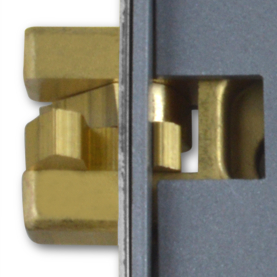

Claw Bolt
A claw bolt is a type of locking mechanism typically used on sliding doors, featuring pivoted claws that swing outward when the bolt is engaged. These claws hook onto the frame or strike plate, offering increased resistance to forced entry by securing the door at multiple points. The claw bolt’s design makes it particularly suited for sliding and bi-fold doors, where traditional bolts may not be effective. It provides a higher level of security by preventing prying or lifting of the door. Claw bolts are popular in industrial, commercial, and some residential sliding door applications.


Curtain
When a user turns the key the curtain (also known as a bolt thrower) mechanism moves the bolt into the strike plate or door frame, effectively locking the door. The curtain works by converting rotational motion (from turning a key or handle) into linear motion, driving the bolt forward or backward. The distance that the bolt extends into the frame, known as the “throw,” is an important measure of security; a longer throw means deeper engagement with the frame, making forced entry more difficult. Curtains are precision-engineered for smooth, reliable operation, minimising the wear and tear on both the lock and the door.
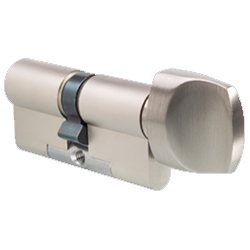

Clutch Release Function
A clutch release function is a feature in locks allowing the key to override a thumb turn lock from the outside, even if the thumb turn is being held in a locked position from inside. This mechanism is ideal for areas where individuals without a key could inadvertently hold the thumb turn locked, potentially blocking entry. By engaging the clutch, the lock temporarily disconnects the thumb turn, letting the authorised keyholder unlock the door from outside. This feature enhances security and access control in shared spaces or locations where controlled external access is essential.
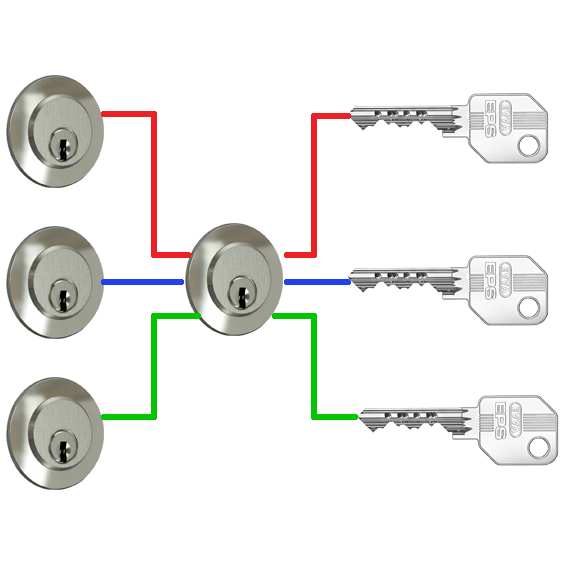

Common Entrance
The common entrance system is used in multi-occupancy buildings, like apartments, office complexes, and hotels, allowing individual keys to open communal doors. Each occupant has a unique key for their unit that cannot open other individual locks but will operate shared entry doors, such as main entrances, mailrooms, or service areas. This system simplifies access management, as each resident can enter shared spaces without compromising the security of private areas. Common entrance systems are popular in environments requiring secure, regulated access, improving both convenience for residents and security for property managers.


Compression (H.264/H.265)
Video compression technologies like H.264 and H.265 reduce the file size of CCTV footage while maintaining image quality. Compression is essential for efficient storage and transmission, especially in IP-based systems with high-resolution cameras. H.264 is widely used for standard HD videos, while H.265, also known as HEVC (High-Efficiency Video Coding), offers better compression, reducing file sizes by up to 50% compared to H.264. This allows for longer recording durations and faster streaming over limited bandwidth. Choosing the right compression standard ensures optimal storage usage and seamless video playback without compromising surveillance quality.
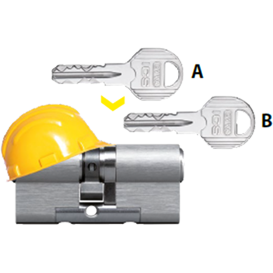

Construction Keying
Construction keying is a temporary access solution during building projects, granting contractors unrestricted entry until project completion. With this setup, a special construction key can operate designated locks, but this access is revoked once a master key is first inserted and turned. This action disables the construction key, transferring control to the master key permanently. Construction keying provides contractors and subcontractors access without risking security once the project ends. This approach is efficient for construction sites, ensuring that only authorised personnel can enter during and after the construction period.
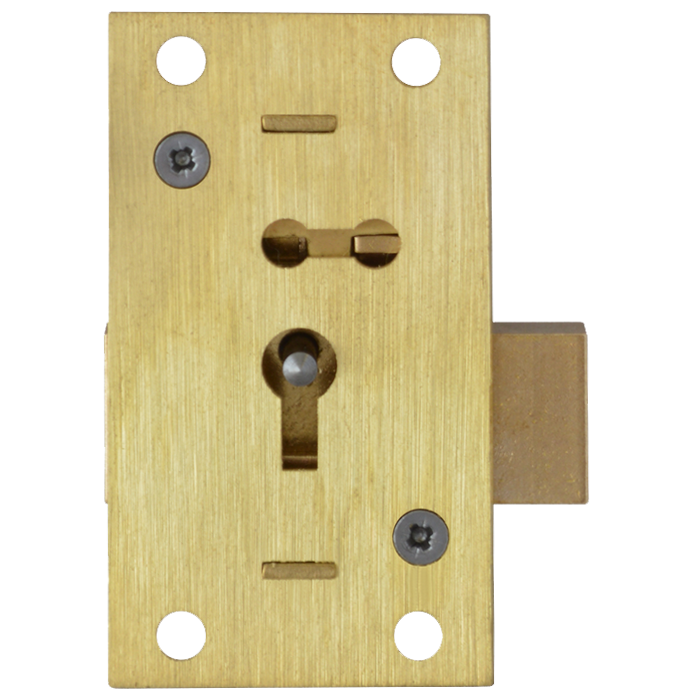

Cupboard Lock
Cupboard locks are general-purpose locks designed to secure doors on storage furniture like cupboards, cabinets, and drawers. Available in multiple styles, including cam, deadbolt, and latch variations, these locks serve residential, office, and industrial needs. Cupboard locks prevent unauthorised access to personal items, sensitive documents, or supplies. They can be keyed alike across multiple cupboards for ease or uniquely keyed for added security. Their compact sise and simplicity make cupboard locks practical and affordable solutions for securing storage spaces, keeping items protected from casual access or tampering in various settings.
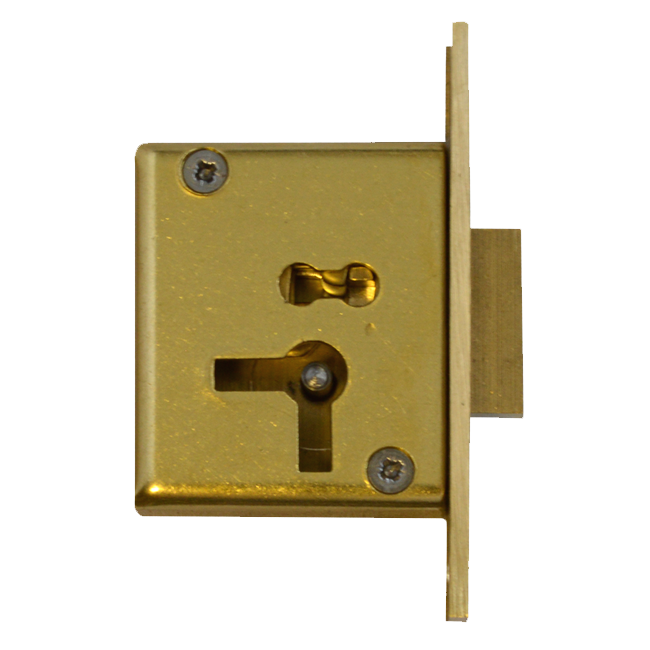

Cut Cabinet Lock
A cut cabinet lock is designed to sit flush with the surface of a cabinet door or drawer by recessing its flange into the wood. This installation style provides a cleaner, more integrated look while preventing the lock from protruding. Cut cabinet locks are commonly found on higher-end furniture where aesthetics and security are both priorities. The flush design makes it harder for potential intruders to tamper with or pry open the lock. Cut cabinet locks offer a more secure and visually pleasing option for furniture, keeping belongings safe while maintaining design continuity.
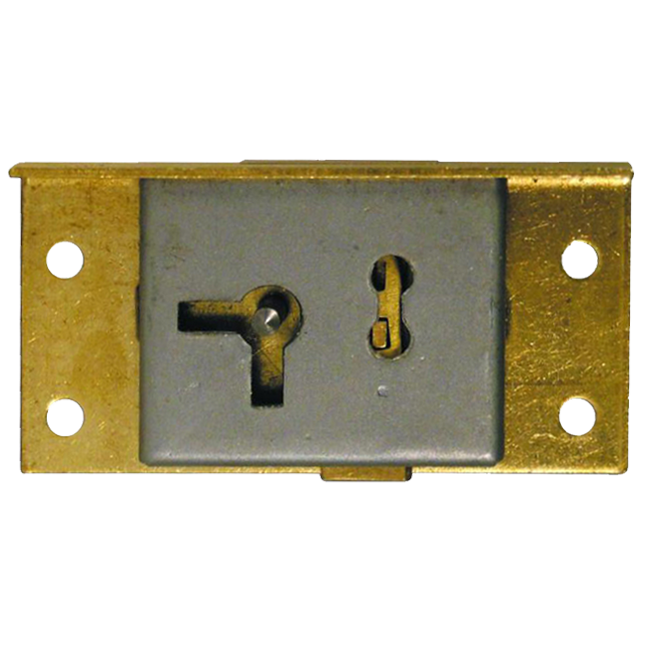

Cut Cupboard Lock
Similar to the cut cabinet lock, a cut cupboard lock features a recessed flange, enabling the lock to sit flush with the surface of a cupboard door or drawer. This recessed installation provides a streamlined appearance and reduces opportunities for tampering, as the lock does not protrude. Cut cupboard locks are ideal for maintaining a smooth, integrated look on cupboards while providing enhanced security for stored items. These locks are typically used in high-quality furniture where aesthetics and durability are essential, offering protection for items in private or commercial settings.
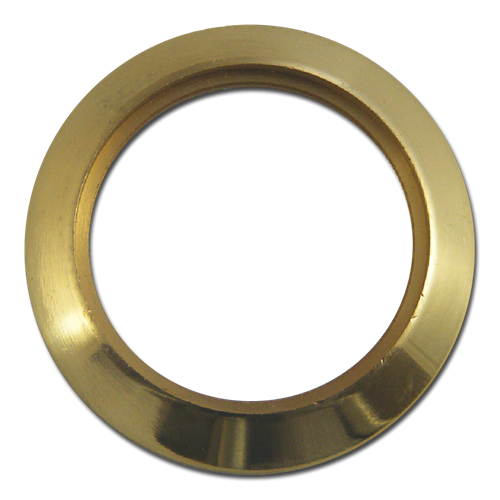

Cylinder Rose
A cylinder rose is a decorative ring that encircles the face of a rim or screw-in cylinder, providing a refined appearance and protecting the surrounding area from wear. Cylinder roses are used on doors to cover the installation hole edges, giving a polished and tidy look. Often made from metal, they come in various finishes to complement different door hardware styles. Besides aesthetics, the cylinder rose can also offer minor protection against tampering by preventing direct access to the lock cylinder’s edge. This accessory is both practical and decorative, enhancing the door’s overall look and durability.
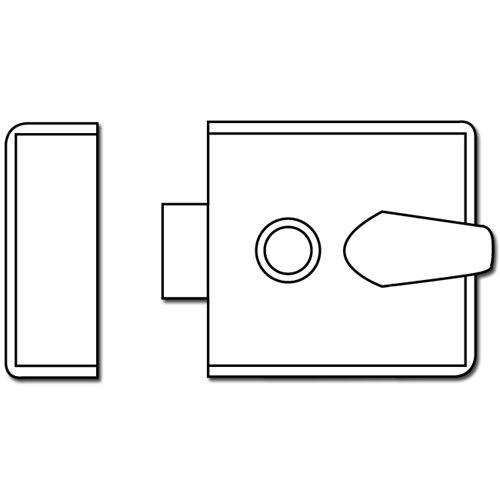

Deadlatch
A deadlatch is a type of nightlatch or latch mechanism where the latch can be locked securely in place, preventing it from retracting without a key. Unlike a simple latch, the deadlatch provides extra security, as it cannot be “slipped” back open with a thin object. Deadlatches are commonly found on external doors, providing a layer of security against unauthorised entry while allowing easy egress from the inside. They’re often used in both residential and commercial doors due to their balance of convenience and security, combining ease of entry with effective locking capabilities.


Differs
“Differs” refers to the number of possible unique key combinations that a lock can have, representing the lock’s potential for unique keying permutations. The number of differs in a lock increases with its complexity and security features, such as the number of pins in a cylinder or levers in a mortice lock. Higher differs indicate greater security by reducing the likelihood of key duplication or manipulation. This term is essential for understanding a lock’s security level, as a higher number of differs allows for more unique keys, making the lock harder to bypass with another key.


Double Locking
Double locking is a security feature that deadlocks a door by turning the key in the opposite direction in the outside cylinder, adding protection against forced entry. With double locking engaged, the lock is immune to manipulation of the internal handle or "slipping" methods, where the latch could be pried open. This feature is common in many external door locks, including deadbolts and certain latch systems, and enhances security by making the lock harder to bypass. Double locking is widely used in residential and commercial buildings for its increased protection against unauthorised entry.
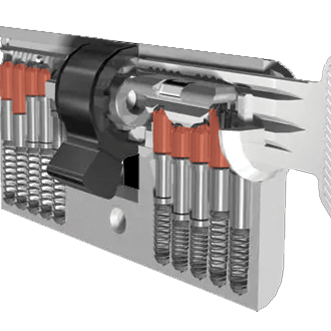

Driver (Top Pin)
In a pin tumbler lock, the driver, or top pin, is the pin positioned directly above the key pin (or code pin). When the correct key is inserted, it aligns the driver with the key pin, creating the shear line that allows the lock to turn. The driver is essential to the lock's function, as it works in conjunction with the key pin to ensure that only the correct key can open the lock. This design is foundational in pin tumbler locks, widely used in residential and commercial security due to its effectiveness and reliability.
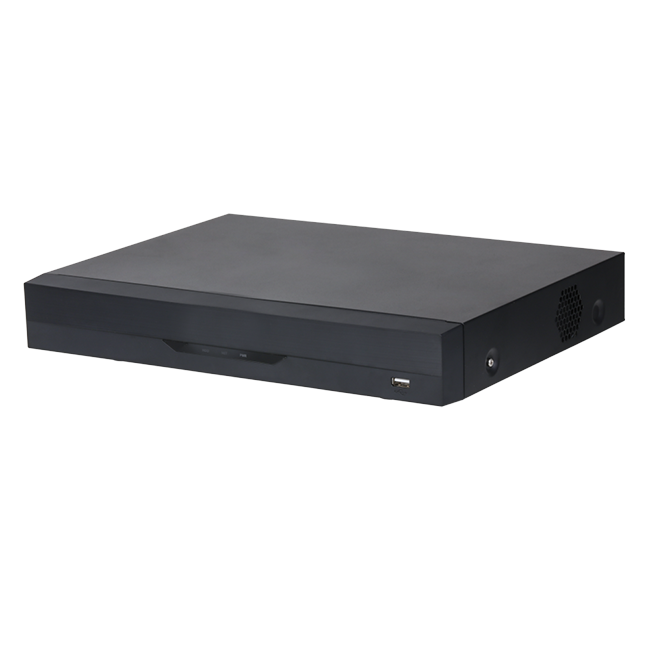

DVR (Digital Video Recorder)
A Digital Video Recorder (DVR) is a device that records video footage from analog CCTV cameras and stores it on a hard drive. DVRs are the backbone of traditional surveillance systems, allowing users to review recorded footage and manage video feeds. Equipped with multiple input channels, DVRs can support several cameras simultaneously. They often include features like motion detection, scheduling, and playback options. Video is typically encoded using formats like H.264 to save storage space. While DVRs are primarily used with analog cameras, they remain a popular choice for budget-friendly surveillance setups in homes and small businesses.
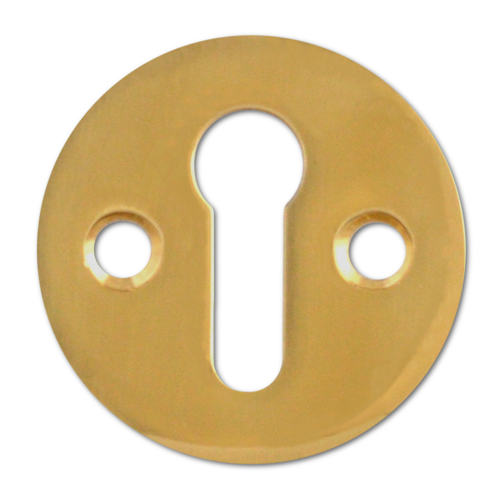

Escutcheon
An escutcheon is a protective plate or decorative cover that fits around a keyhole or cylinder. It shields the lock from dust and dirt and prevents damage to the surrounding door area, particularly when keys are frequently inserted. Escutcheons also enhance a door’s aesthetics, coming in various materials and finishes to match the door hardware. In addition to providing an attractive appearance, an escutcheon can offer minor tampering protection by concealing the edges of the lock cylinder. They are commonly found on both residential and commercial doors, combining style with functional protection.


Field of View (FoV)
The Field of View (FoV) of a CCTV camera defines the area visible through its lens, often measured in degrees. A wider FoV allows the camera to cover larger spaces, while narrower angles focus on specific details. FoV depends on the camera's sensor size and lens type; for example, a fisheye lens offers a 180-degree view, while a telephoto lens provides a tight, detailed perspective. Understanding FoV is crucial for selecting the right camera for an application. Wide FoV cameras are suitable for open areas like parking lots, while narrow FoV cameras excel in identifying details in confined spaces.
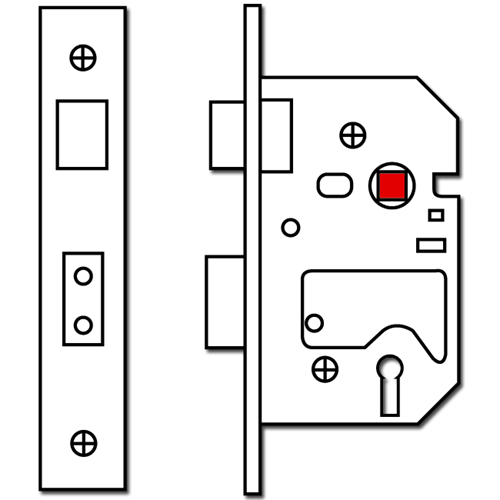

Follower
The follower is the square hole within a lock mechanism that accepts a spindle, which is attached to the door handle or knob. When the handle or knob is turned, the spindle rotates within the follower, engaging the lock’s latch or bolt. The follower is central to the function of sash and mortice locks, as it transmits the motion from the handle to the internal locking mechanism. Made of durable materials to withstand wear, followers are integral to the lock’s operation, ensuring that turning the handle translates effectively to locking or unlocking the door.
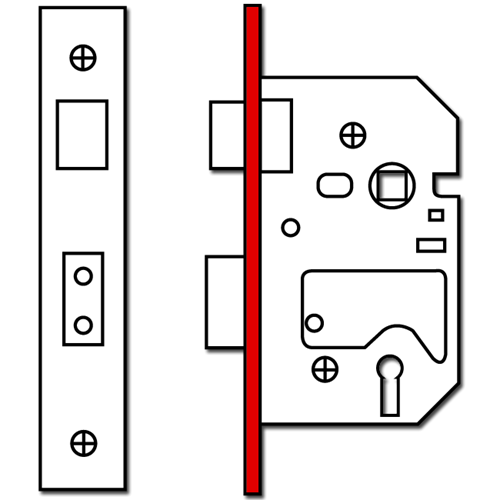

Forend
The forend is the front face of a lock that is visible on the door edge and secured with screws. It is often made of metal and features a rectangular shape with screw holes and an opening for the latch or bolt. The forend plate provides stability to the lock and gives a finished look to the installation. Forend plates are available in various finishes, complementing door aesthetics while providing reinforcement to the lock. Essential in both mortice and sash locks, the forend enhances durability and helps align the lock with the door frame.
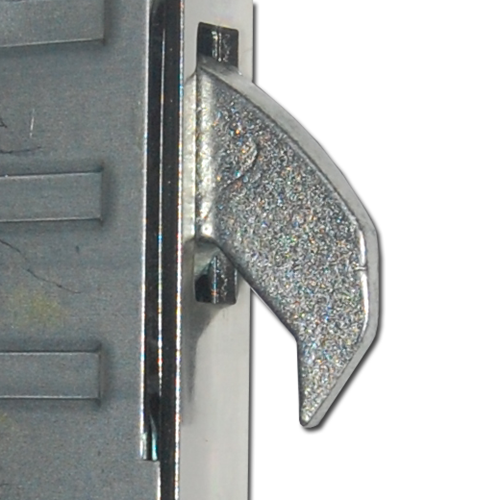

Hook Bolt
A hook bolt is a hook-shaped locking bolt typically used in deadlocks on sliding doors. When engaged, the hook swings down to latch securely into the door frame, preventing the door from being pried open or lifted off its track. Hook bolts are popular in sliding patio doors, where traditional bolts might be ineffective against forced entry. The design makes it challenging to bypass the lock, as the hook secures the door at an angle. This mechanism offers additional security for sliding doors in both residential and commercial applications, deterring unauthorised access.


Infrared (IR)
Infrared (IR) technology enables CCTV cameras to capture clear images in low-light or no-light conditions. IR cameras use infrared LEDs to illuminate the scene with light invisible to the human eye. This feature is particularly useful for night time surveillance or monitoring dark areas like basements and warehouses. The effectiveness of IR depends on the number and strength of the LEDs, determining the camera's night vision range. Modern IR cameras often include smart features like adaptive IR, which adjusts brightness to prevent overexposure. Infrared technology ensures continuous monitoring and enhances security in environments with poor lighting.
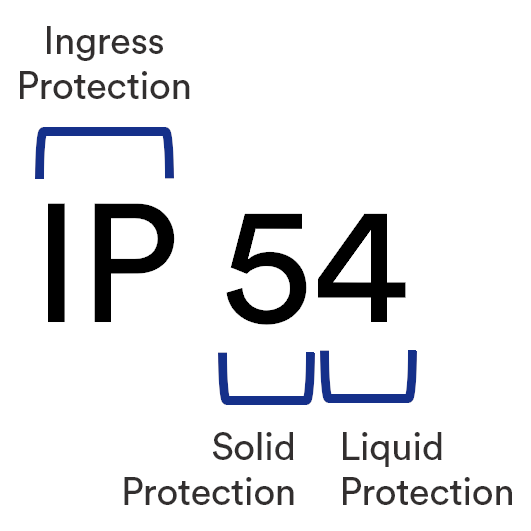

Ingress Protection (IP)
Ingress Protection (IP) is a classification system that rates a device's protection against solid particles, dust, and water intrusion. IP ratings consist of two numbers: the first indicates the level of protection against solids, and the second indicates water resistance. For example, an IP65 rating means complete dust protection and resistance against low-pressure water jets. IP ratings are vital in determining the durability and suitability of locks and other hardware for various environments, such as outdoor installations or areas exposed to moisture, ensuring they withstand environmental challenges and continue functioning effectively.
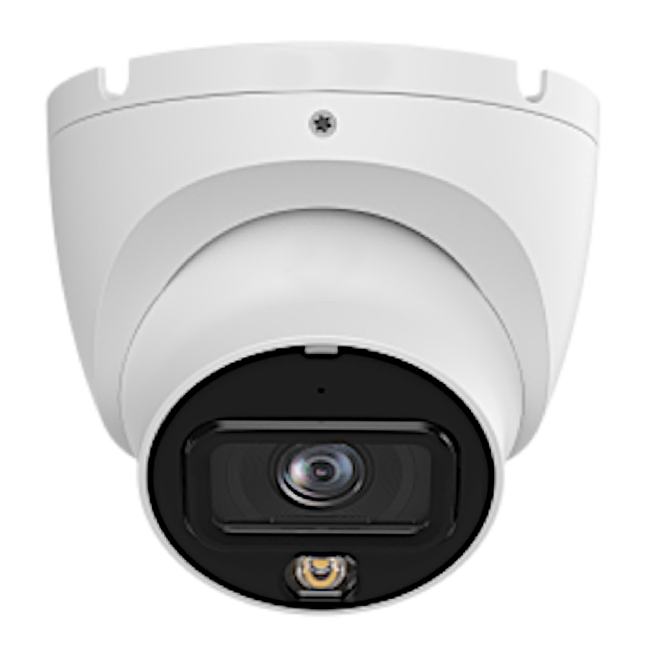

IP Camera
An IP camera, or Internet Protocol camera, is a digital surveillance device that transmits video over a network. Unlike traditional analog cameras, IP cameras use an internet connection to send and receive data, enabling remote viewing and management from computers, smartphones, or tablets. These cameras offer higher resolutions, clearer images, and advanced features like motion detection, night vision, and intelligent analytics. Many IP cameras support Power over Ethernet (PoE) for simplified installation. They are widely used in both residential and commercial settings, providing scalable solutions for modern surveillance systems. Compatibility with network video recorders (NVRs) enhances their functionality and reliability.
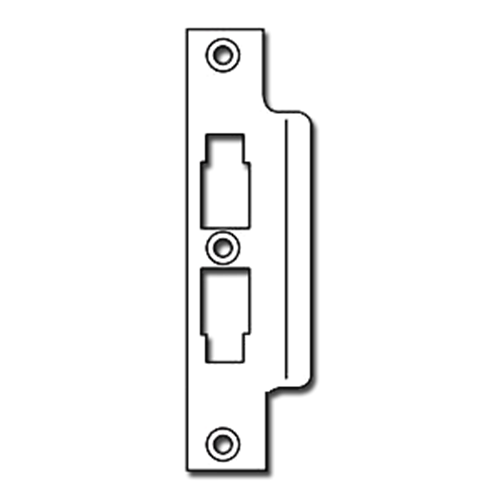

Keep (Strike Plate)
The keep, also known as the strike plate, is a metal plate installed on the door frame where the bolt or latch of the lock extends into when the door is closed. It aligns with the lock and provides reinforcement to withstand the force exerted during door closing and opening. Strike plates come in various styles, often with reinforced edges to resist forced entry attempts. Keeps play a crucial role in lock security, ensuring the bolt has a secure position within the frame, reducing wear on the door and lock, and preventing damage to the door frame.


Key Bit
The key bit is the part of a mortice key that is uniquely cut to engage with the lock’s internal levers or pins. When inserted, the bit interacts with the lock mechanism, lifting levers or aligning pins to open the lock. The design and cut of the key bit are specific to each lock, providing security by ensuring only the correctly cut key can operate the lock. In mortice locks, the key bit’s design is critical to functionality, allowing the user to lock and unlock the door securely. The bit contributes directly to the uniqueness and security of each key.


Key Blank
A key blank is an uncut key that has not been shaped to fit any specific lock. Key blanks serve as the starting point for creating custom keys, as they can be cut to match the unique configuration of a lock. Locksmiths use key blanks to make duplicates or new keys for existing locks. Blanks come in various shapes, sises, and profiles to suit different types of locks, such as mortice, cylinder, or tubular locks. Key blanks are essential in security settings where multiple copies or replacement keys are needed, allowing for precise, customisable key creation.


Key Bow
The key bow is the head or handle part of a key blank, providing a grip for the user when inserting and turning the key. Often designed with ergonomic features, the bow helps users identify and differentiate keys based on shape or markings. In addition to being practical, key bows often carry branding, logos, or aesthetic features. Bows are typically made of durable materials, such as brass, steel, or aluminum, to withstand frequent handling. While not directly involved in the locking mechanism, the bow’s design enhances usability, allowing for easy identification and comfortable handling of keys.
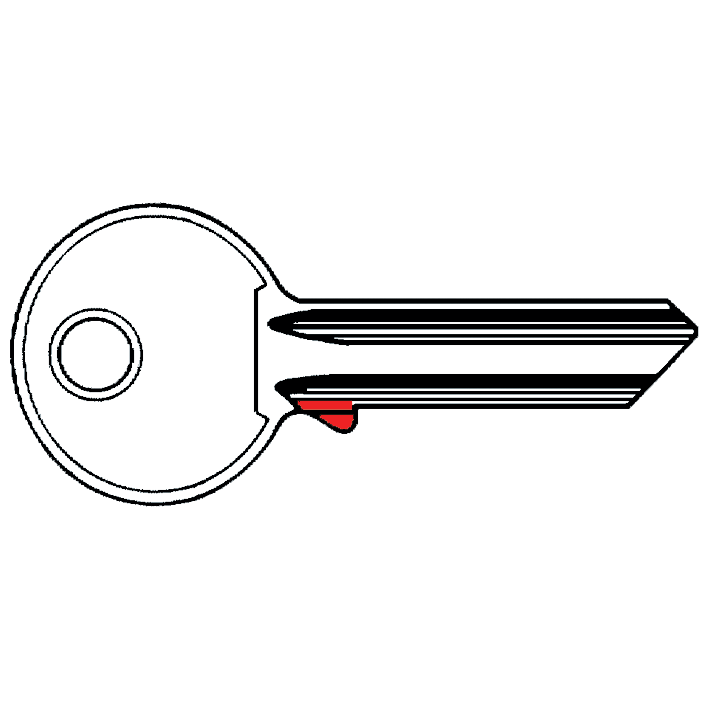

Key Shoulder
The key shoulder refers to the part of a key where the wider blade meets the narrower shaft or bow, serving as a stopping point when the key is inserted into a lock. The shoulder controls how deeply the key can go into the lock and ensures that the notches (or bitting) on the key align precisely with the pins or wafers inside the lock. Proper alignment allows the key to turn and unlock the mechanism. The key shoulder is essential for ensuring a secure, precise fit and proper function within the lock.
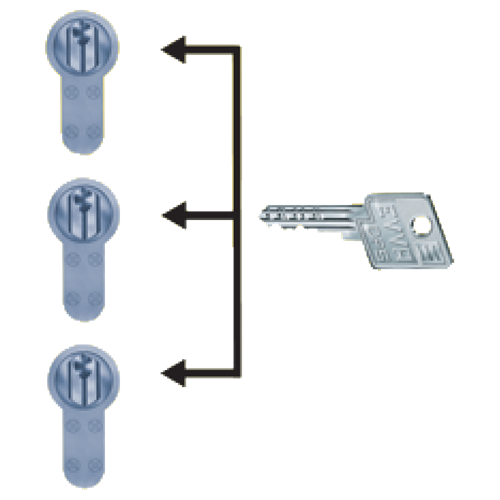

Keyed Alike
A keyed alike system allows multiple locks to be operated by a single key, providing convenience and reducing the need to carry multiple keys. For example, a front and back door could both be keyed alike, so one key can open both doors. Keyed alike systems are commonly used in residential and commercial settings where convenience is prioritised over the complexity of separate keys. However, it’s important to note that the security level remains the same as individual keyed locks, as the key only matches those locks explicitly configured for keyed alike functionality.
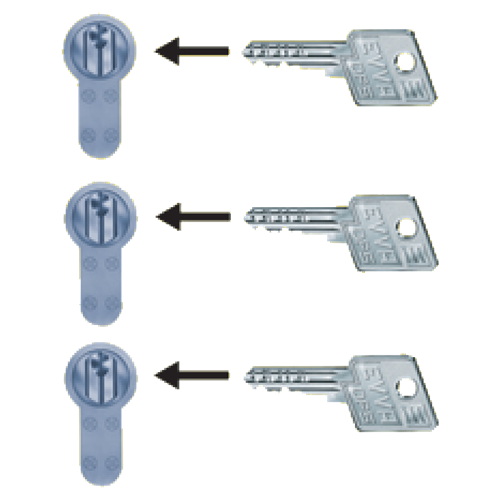

Keyed To Differ
In a keyed-to-differ system, each lock is operated by its own unique key, and no other key should open it. This arrangement maximises security by ensuring that only specific keys operate specific locks. Keyed-to-differ locks are widely used in residential, commercial, and industrial settings where access needs to be controlled individually. However, due to a finite number of possible key combinations (or "differs"), identical keys might still appear in large installations, although the risk is minimal. Keyed-to-differ setups are ideal when access to certain areas needs to be restricted to designated individuals.
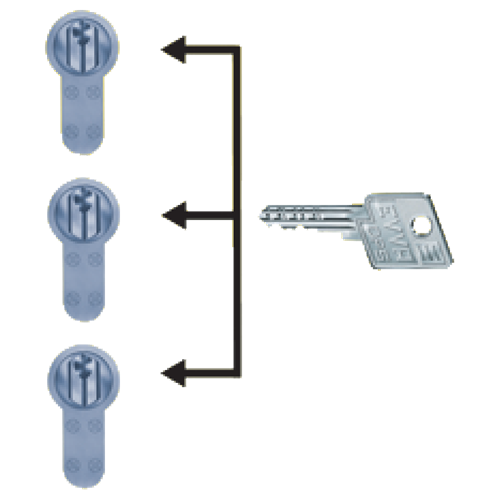

Keyed To Pass
“Keyed to pass” is another term for keyed alike, where multiple locks are configured to operate with the same key. This arrangement is commonly used in environments where convenience is prioritised, allowing users to carry a single key to unlock multiple doors. Keyed-to-pass systems are ideal for simplifying access in homes or small commercial spaces, where multiple entries can be accessed by one key. While it offers convenience, the security level remains the same as standard keyed locks, as access is still controlled by matching the specific locks configured for keyed alike functionality.
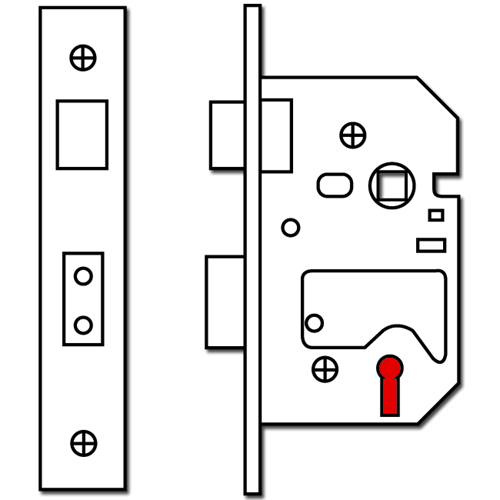

Keyhole
The keyhole is the part of a lock or cylinder where the key is inserted to operate the locking mechanism. Positioned to align with the internal components, the keyhole guides the key’s entry to allow it to interact with pins, levers, or tumblers within the lock. Keyholes are designed to accommodate specific key shapes or profiles, enhancing security by ensuring only the correct key can activate the lock. Keyholes are a defining feature in traditional locks, though modern locks may use alternative access points such as keypads or card readers for entry.


Keyway
The keyway is the opening in a lock or cylinder where the key is inserted, guiding it into position to align with the lock’s internal mechanism. The shape and profile of the keyway are precisely designed to match only the intended key, providing a unique, secure fit that prevents unauthorised access. Keyway designs vary widely to add layers of security, making it challenging to use generic or copied keys. A well-designed keyway enhances a lock's pick resistance, as specialised tools would be needed to manipulate the internal pins or levers without the correct key.
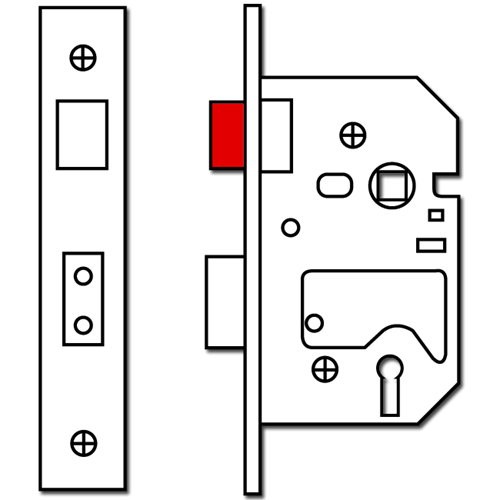

Latch
A latch is a spring-loaded bolt designed to hold a door in a closed position without locking it. Typically operated by the door’s handle or knob, the latch extends to catch onto a strike plate in the door frame, keeping the door shut. Latches are commonly used on internal doors and are not intended to provide significant security but rather to keep doors from opening inadvertently. Latch bolts can be retracted by turning the door handle, allowing easy access without the need for a key, making them convenient for everyday use.
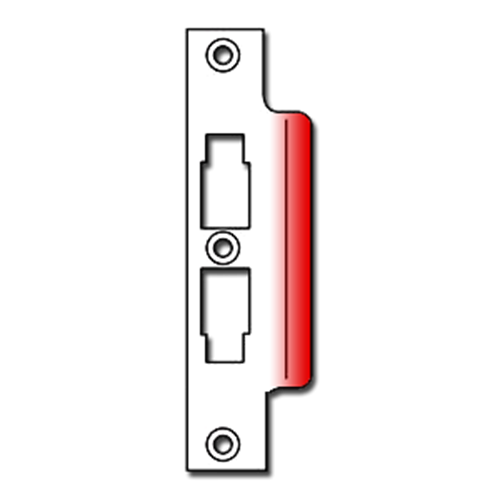

Lip (Strike Plate)
The lip on a strike plate is the flat surface where a latch or bolt first makes contact when closing the door. This surface is critical in guiding the latch into place, reducing the likelihood of damage to the lock mechanism and door frame. Positioned slightly outward, the lip helps to smoothly catch the latch bolt, ensuring secure door closure. The lip’s design enhances durability by protecting the edge of the strike plate and reducing impact forces that can cause wear. Strike plates with well-designed lips help improve the door's alignment and prolong lock functionality.
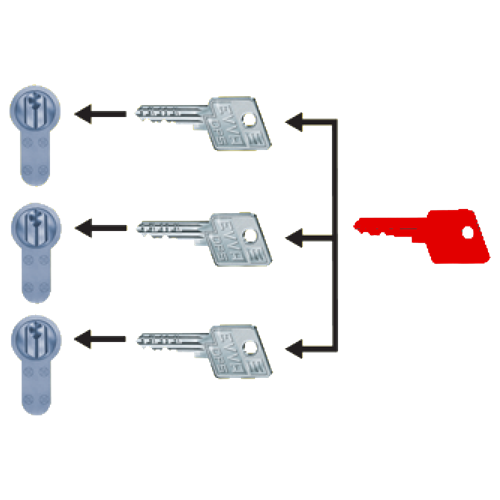

Master Key
A master key is a specialised key that can open every lock within a master-keyed system. In this setup, individual locks are assigned unique keys, while the master key provides universal access to all of them. Master keys are widely used in commercial or multi-residential buildings, where administrators, landlords, or maintenance staff require access to all units. This system provides flexibility by allowing specific access rights while retaining overall control through the master key. Master-keyed systems are practical for efficiently managing multiple access points while maintaining the security of individual locks.
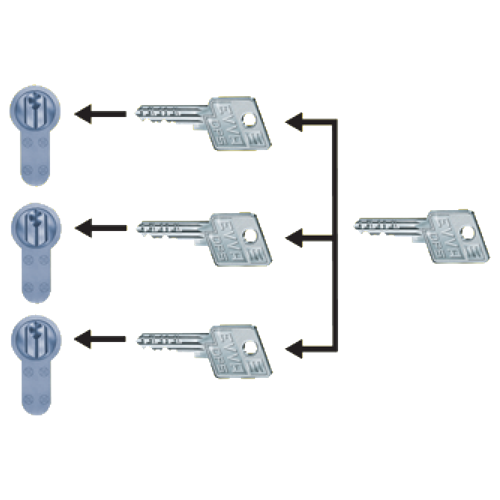

Master Keyed
A master-keyed system allows each lock to be operated by its unique key, while a master key can open all locks in the system. This arrangement is frequently used in multi-occupancy buildings, such as apartments or office complexes, where tenants have individual keys but landlords or security personnel hold a master key. Master-keyed systems balance security and convenience, as each user has private access, yet designated personnel retain comprehensive control. This setup is ideal for situations where hierarchical access is necessary, enabling both individualised security and central management.
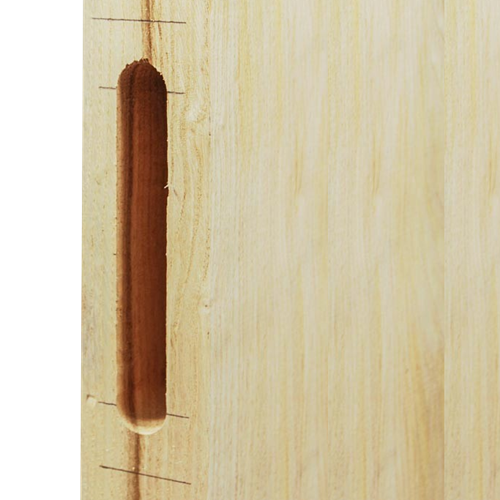

Mortise/Mortice
A mortise is a recessed slot cut into wood to house a lock or other hardware. Mortise locks fit within these cutouts, allowing for a more secure and flush installation compared to surface-mounted locks. Mortise locks are widely used in both commercial and residential doors due to their strength and durability, as the lock body is secured within the door itself. Mortising requires precise cutting and installation, making it compatible with doors that demand a higher level of security and durability. Mortised installations also provide an aesthetically pleasing finish, with minimal protrusion from the door.
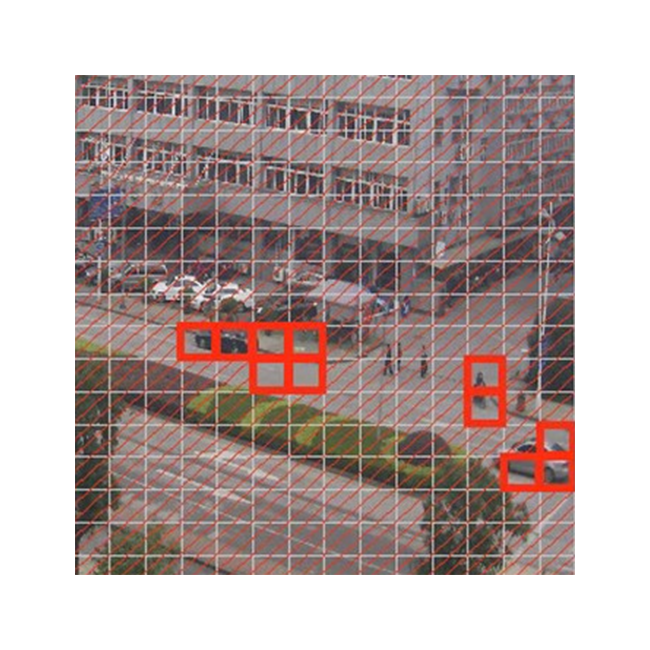

Motion Detection
Motion detection is a feature in CCTV cameras that identifies movement within a defined area, triggering alerts, recording, or specific actions. Using advanced algorithms, motion detection systems analyze changes in the scene captured by the camera, distinguishing between significant movements and minor changes, such as shifting shadows. This feature conserves storage space and bandwidth by recording only when motion is detected. It is commonly used in residential and commercial surveillance to reduce false alarms. Integrated with security systems, motion detection enhances responsiveness, notifying users via alerts or activating lights and alarms when unauthorised activity is detected.


Mushroom Pin
A mushroom pin is a pin shaped like the letter "I" commonly used in pin tumbler locks to provide extra protection against picking. Its unique shape causes it to catch on the shear line when an incorrect picking attempt is made, creating false feedback for the lockpicker. This shape provides enhanced security by making it difficult for unauthorised individuals to manipulate the lock mechanism. Mushroom pins are frequently found in high-security locks, where resistance to picking is essential. Their design is a critical component in anti-picking technology, adding a valuable layer of security to pin tumbler systems.


Nightlatch
A nightlatch is a type of lock that automatically engages a latch when the door closes. It is typically mounted on the door’s surface and can be operated with a key from the outside and a thumb turn or button from the inside. Nightlatches often have an internal button that can hold the latch in the extended or withdrawn position, giving users flexibility in securing the door. Widely used in residential properties, nightlatches provide a convenient locking solution, offering easy exit from the inside while ensuring the door locks upon closure from the outside.
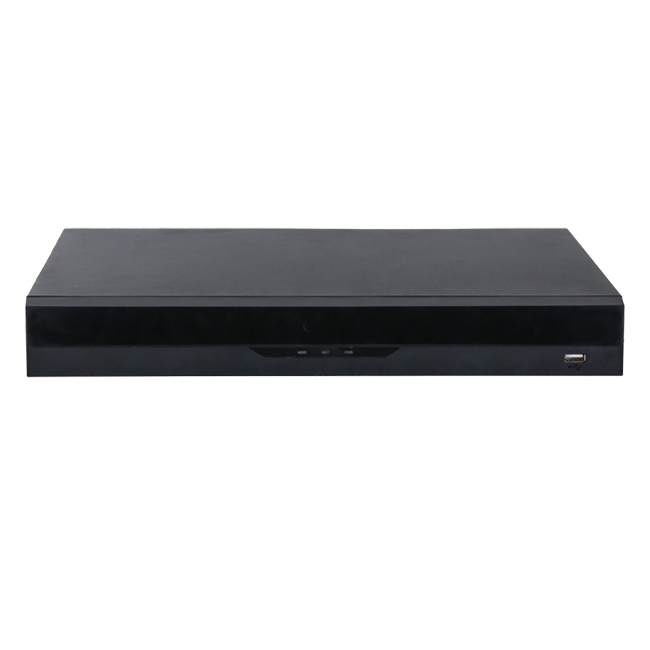

NVR (Network Video Recorder)
A Network Video Recorder (NVR) is a device that records video directly from IP cameras over a network. Unlike DVRs, which require analog cameras, NVRs work seamlessly with digital systems, offering superior video quality and scalability. They store footage on internal or external drives and allow remote access through smartphones, tablets, or PCs. Advanced features include intelligent analytics, motion detection, and event notifications. NVRs are easier to install with PoE-enabled devices, requiring only a single Ethernet cable for power and data. Ideal for modern surveillance systems, NVRs are widely used in homes, offices, and industrial settings.
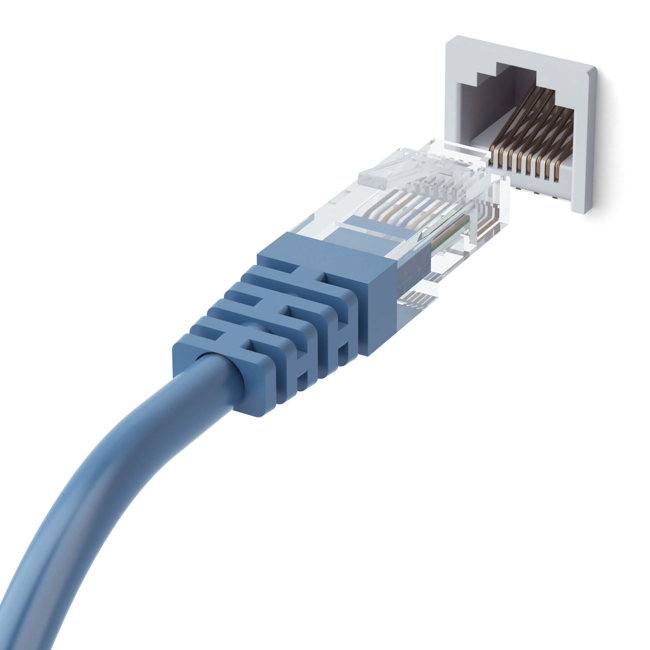

POE (Power over Ethernet)
Power over Ethernet (PoE) technology allows CCTV cameras to receive power and data through a single Ethernet cable. This simplifies installation by eliminating the need for separate power sources, reducing cable clutter and installation costs. PoE is commonly used in IP camera systems, making it easier to deploy cameras in hard-to-reach areas. Advanced PoE standards, like PoE+ and PoE++, provide higher power levels, supporting devices like PTZ cameras and infrared illuminators. PoE ensures reliable power delivery and is scalable, making it a preferred choice for modern surveillance systems in residential, commercial, and industrial applications.
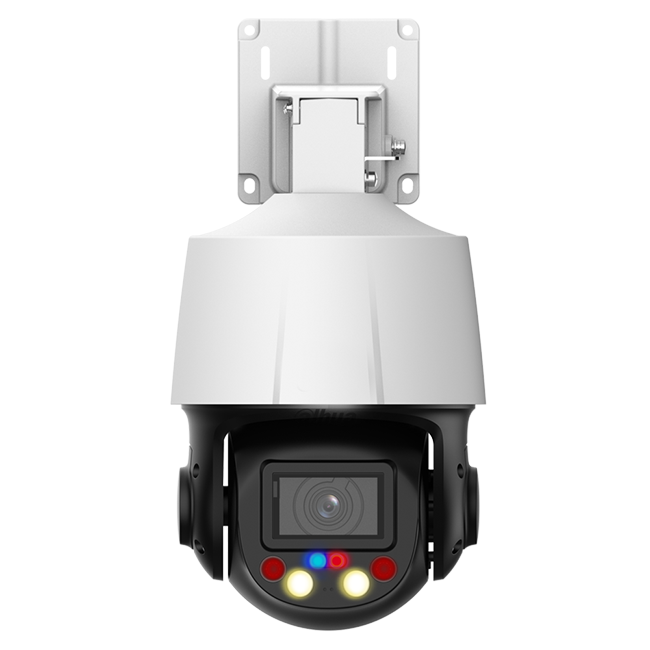

PTZ Camera (Pan-Tilt-Zoom)
PTZ cameras, or Pan-Tilt-Zoom cameras, are versatile surveillance devices capable of remotely adjusting their view. These cameras can pan (rotate horizontally), tilt (move vertically), and zoom in or out to cover large areas or focus on specific objects. Controlled manually or automatically, PTZ cameras are ideal for monitoring expansive spaces like parking lots, stadiums, and warehouses. Advanced models include features such as presets, patrol modes, and motion tracking. PTZ cameras are often integrated into centralized security systems, enabling operators to respond dynamically to events. Their flexibility makes them indispensable for dynamic, high-security environments.
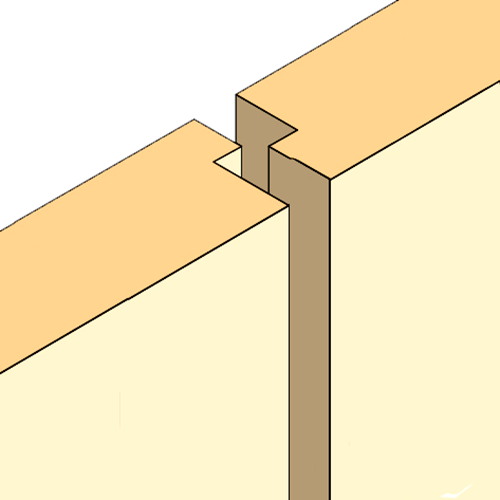

Rebate
A rebate is a rectangular groove or recess cut into the edge of a piece of timber to receive a mating piece, creating a seamless fit between two components. In door hardware, a rebate is often cut into the meeting edge of double doors, allowing them to close flush without a gap. Rebates provide additional strength and stability in door installations, enhancing security by minimising gaps that could be pried open. They are commonly used in mortice locks on double doors, where rebated edges ensure a precise, secure alignment when the doors are shut.
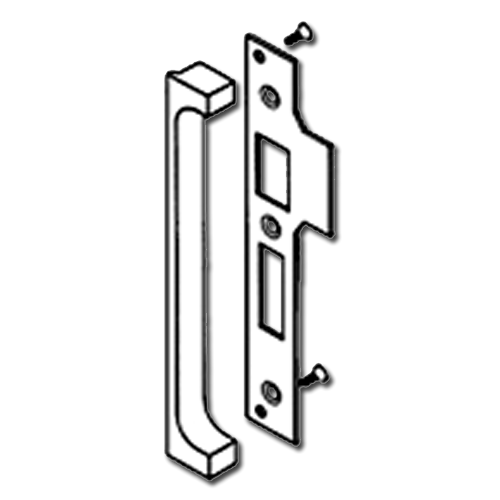

Rebate Set
A rebate set is a component kit used to adapt a standard mortice lock with a flat forend to fit rebated doors. The set typically includes specialised forend and strike plate pieces that accommodate the stepped edges of rebated door frames. This conversion is necessary for mortice locks installed on double doors with rebated meeting stiles, ensuring the lock functions correctly with the door’s profile. Rebate sets are essential for customising lock installations, maintaining secure alignment on rebated doors. They are widely used in both residential and commercial double-door applications for their compatibility and versatility.
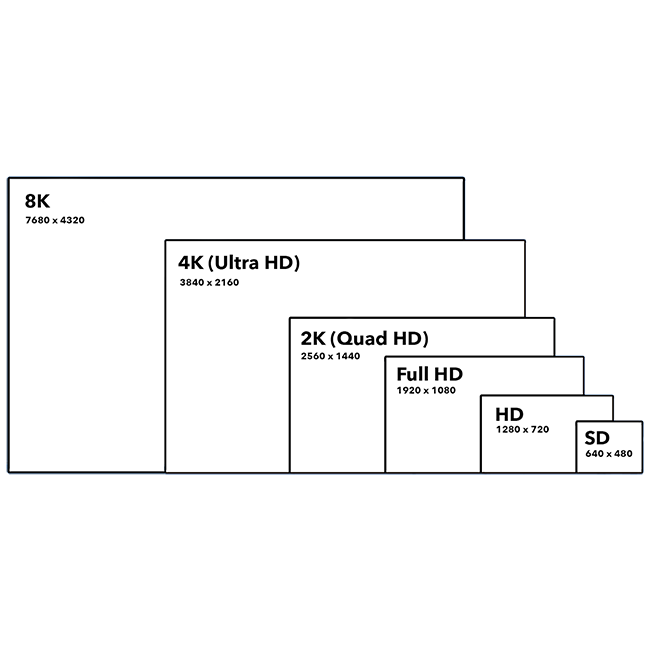

Resolution
Resolution refers to the clarity and detail of video footage captured by CCTV cameras. It is measured in pixels, such as 720p, 1080p, or 4K, where higher numbers indicate greater image sharpness. High-resolution cameras are essential for identifying faces, license plates, or other details in surveillance footage. Analog systems typically offer lower resolutions, while IP-based systems can achieve HD or Ultra HD quality. Choosing the right resolution depends on the application; for example, wide areas like parking lots may require higher resolutions than small indoor spaces. Balancing resolution with storage and bandwidth needs ensures optimal performance.
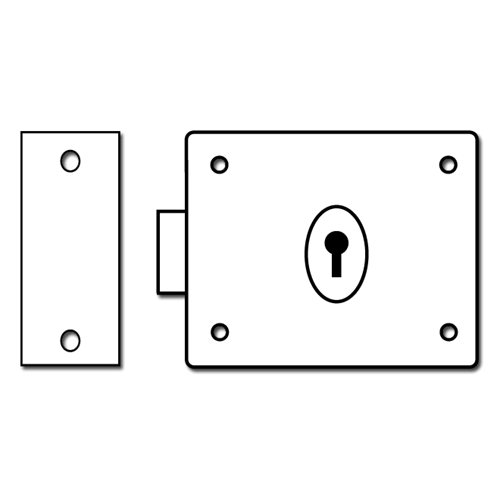

Rim Lock
A rim lock is a surface-mounted lock installed on the interior face of a door rather than being recessed into it. This type of lock includes a lock body and a latch that projects into a corresponding strike plate on the door frame. Rim locks are popular for their ease of installation and suitability for doors where morticing is impractical, such as thin or historically significant doors. Although rim locks may lack the flush appearance of mortice locks, they offer reliable security and are frequently used in older homes, sheds, and interior doors for functional and decorative purposes.


Rose
A rose is a circular or decorative ring fitted around the face of a cylinder or knob, providing a neat, finished look to the lock’s appearance. It hides screws and attachment points, enhancing the door's aesthetics and protecting the lock cylinder edges from wear. Roses come in various designs and finishes to match door hardware, adding a cohesive look to the entryway. Typically found in both modern and traditional locks, roses serve a practical role by shielding the cylinder face and ensuring that the hardware blends seamlessly with the overall design of the door.
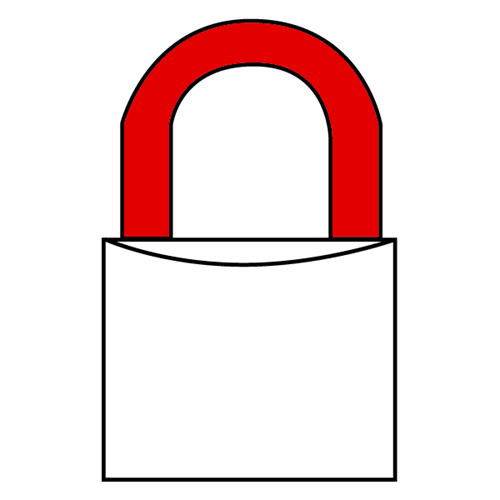

Shackle
The shackle is the U-shaped or hinged metal bar on a padlock that passes through a hasp or other securing point. When the padlock is locked, the shackle secures the item by enclosing or latching onto it. Padlock shackles are commonly made of hardened steel to resist cutting or tampering. They come in different lengths and thicknesses, with extended shackles providing flexibility for securing thicker objects. The shackle is a critical component of padlock security, providing the locking mechanism that holds the padlock in place and secures items against unauthorised access or theft.
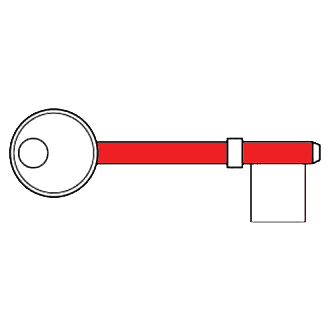

Shank
The shank is the elongated body of a mortice key that connects the head (bow) to the bit, which interacts with the lock’s internal mechanism. Positioned between the handle and the working end, the shank’s length and diameter are specifically designed to fit into the keyway and allow the bit to reach the lock’s levers or pins. A well-crafted shank provides stability and ease of use, allowing smooth insertion and operation within the lock. In traditional mortice locks, the shank is essential for effective alignment and engagement, allowing the key to function securely.
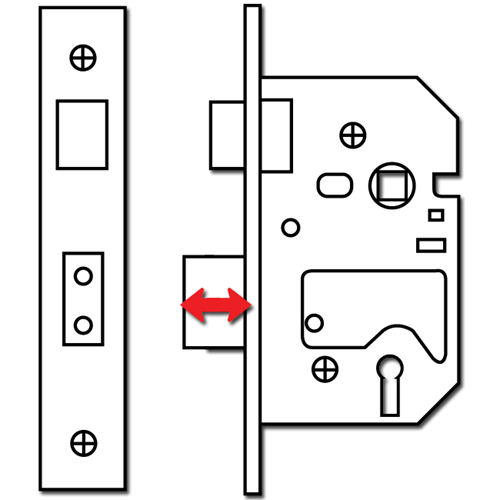

Shoot
In lock terminology, the “shoot” refers to the distance that a bolt or latch extends when it is operated. This measurement is crucial for ensuring the bolt effectively secures the door within the frame or strike plate. A longer shoot provides greater security by ensuring a deeper engagement, reducing the likelihood of forced entry. Locks are often rated by their shoot distance, as this determines how far the bolt moves into the door frame, contributing to the lock’s holding strength. Shoot distances are carefully calibrated to suit specific lock designs and security needs.
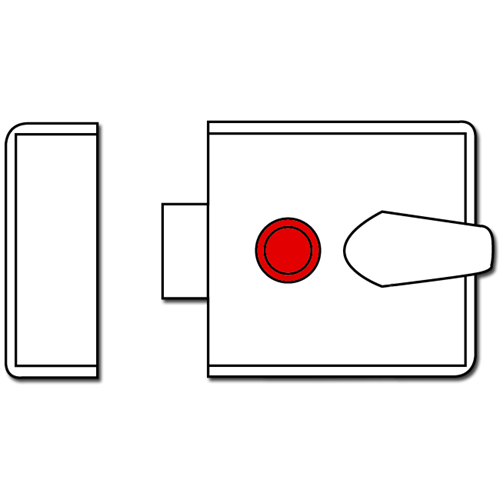

Snib
A snib is a small button or lever on the casing of a nightlatch or rim lock that allows the bolt to be held in either the extended (locked) or retracted (unlocked) position. By activating the snib, users can temporarily prevent the lock from automatically engaging when the door closes. This feature is convenient in homes or offices, where occupants might want quick re-entry without a key. Commonly found on rim nightlatches, the snib offers flexibility and added control over door locking, enabling users to bypass the automatic latching function when desired.


Straight Cabinet Lock
A straight cabinet lock is a type of lock designed for flush mounting on the inside of cabinets, drawers, and doors. Typically used in furniture, it provides a secure, streamlined fit that keeps the lock hidden from view. Straight cabinet locks are ideal for keeping contents secure without altering the cabinet’s appearance, making them popular in both household and commercial settings. These locks are compact yet effective, offering controlled access to cabinets, display cases, and drawers where valuables or sensitive items may be stored. The straight design allows for easy installation and operation.
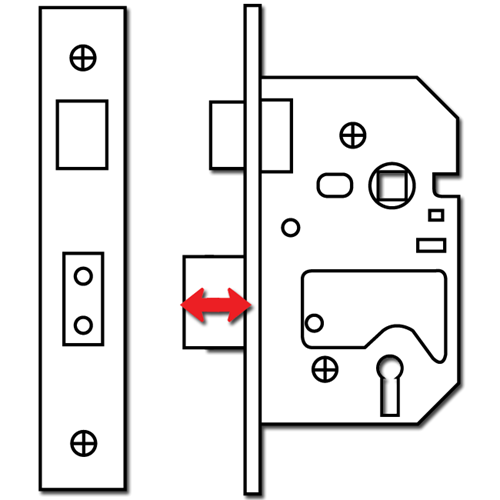

Throw
The “throw” of a lock refers to the distance a bolt or latch moves when it is operated by the key or handle. A longer throw offers increased security by providing a deeper engagement into the door frame, making it more challenging for forced entry attempts. Locks with extended throw distances are often rated as higher security because they offer more substantial engagement within the strike plate or frame. Measuring the throw is essential in door hardware selection, as it ensures the bolt extends adequately to secure the door, providing enhanced safety and durability.
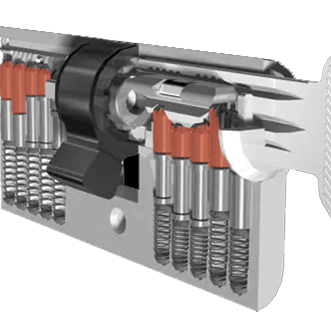

Top Pins
In a pin tumbler lock, the driver, or top pin, is the pin positioned directly above the key pin (or code pin). When the correct key is inserted, it aligns the driver with the key pin, creating the shear line that allows the lock to turn. The driver is essential to the lock's function, as it works in conjunction with the key pin to ensure that only the correct key can open the lock. This design is foundational in pin tumbler locks, widely used in residential and commercial security due to its effectiveness and reliability.


Tumbler
A tumbler is a movable component within a lock that prevents the bolt from moving unless properly aligned by the key. Tumblers come in various designs, such as pins, discs, or levers, depending on the lock type. When the correct key is inserted, it aligns the tumblers to create a shear line, allowing the lock to open. Tumblers are fundamental to the security mechanism, ensuring only the correct key can lift or turn them into the unlocked position. This system is widely used in pin tumbler and lever locks for its effective, secure locking capabilities.
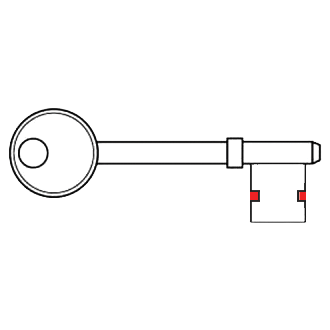

Ward
A ward is a fixed obstruction or lug within a lock that prevents incorrect keys from fully entering or operating the lock. Only keys with a specific cut that matches the shape of the ward can bypass these obstacles and reach the lock’s internal mechanism. Wards provide a level of security by ensuring that only keys with the right profile can access the lock. Warded locks are an older design but remain popular in some applications. While wards are effective against unauthorised key use, they can be relatively easily overcome and are less secure than modern locking mechanisms like pin tumblers.





